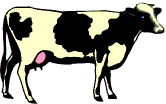
Over the years, we have had several Dandy Design articles dealing with the design seen in horses, deer, elk, moose, and cows. After an article on the stomach of a cow and the remarkable design features that it has, we received the following from Carol Trudell of Iola, Wisconsin. She had this in her files for years and does not know where she got it. It is obvious that it is designed to be a comical piece, but what impresses me is that it shows how an engineer might describe a simple cow in engineering jargon. We all recognize any engineered object is not a product of chance so I felt that even a common cow speaks of the design the Creator has built into all living things.
A Wisconsin cow is a completely automated milk manufacturing machine.
It is encased in untanned leather and mounted on four vertical movable
supports, one on each corner.

The front end of the machine contains the cutting and grinding mechanism as well as headlights, dog catchers, air inlet and exhaust, a bumper, and a foghorn. At the rear, the machine carries the milk-dispensing apparatus as well as an automatic fly swatter and insect repeller. The central portion houses a hydrochemical conversion plant. Briefly, this consists of four fermentation tanks connected in series by an intricate network of flexible plumbing. This part also contains the central heating plant complete with automatic temperature controls, pumping station, and main ventilating system. The waste disposal apparatus is located to the rear of this central section.
Wisconsin cows are available in a variety of colors and sizes. Production output ranges from two to twenty tons of milk per year. In brief, the main external visible features of the Wisconsin cow are: two lookers, two hookers, four stander-uppers, four hanger-downers, and a swishy-wishy.
There is a somewhat similar machine known as the Wisconsin bull,
which is not to be confused with the cow. It produces no milk, but it has
other interesting uses.
Back to Contents Does God Exist?, JanFeb01.